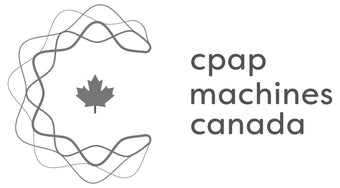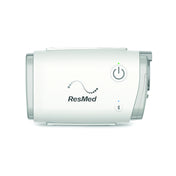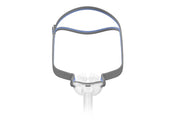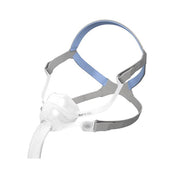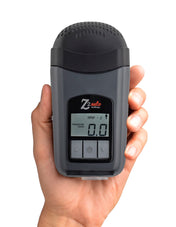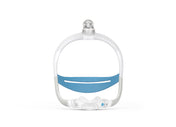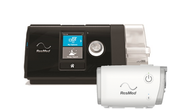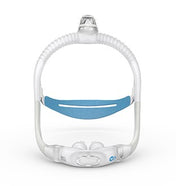Vous en avez probablement entendu parler et connaissez sans doute des personnes qui en souffrent. Non traitée, elle multiplie par 2 à 4 le risque d'accident de voiture¹ , par 3,7 le risque d' AVC² et augmente de 50 % le risque de détresse psychologique³ . Environ 25 % des adultes canadiens souffrent d'une forme ou d'une autre d'apnée du sommeil, et pourtant, seulement 20 % d'entre eux ont reçu un diagnostic⁵ . Alors, que se passe-t-il avec cette affection courante mais sous-diagnostiquée ?
Comprendre l'apnée du sommeil
À l'état de veille, les muscles de notre gorge maintiennent nos voies respiratoires ouvertes, facilitant ainsi une respiration naturelle. Pendant le sommeil, nos muscles, y compris ceux de la gorge, se relâchent. Chez certaines personnes, ce relâchement peut entraîner un rétrécissement ou une fermeture des voies respiratoires, obstruant le flux d'air. Dans ce cas, notre rythme cardiaque et notre tension artérielle augmentent, le taux d'oxygène dans le sang diminue, une poussée d'adrénaline se produit et notre cerveau nous réveille pour relancer la respiration. Dans les cas les plus graves, ce cycle peut se répéter plus de 30 fois par heure, imposant une contrainte importante à notre système cardiovasculaire et nous empêchant de bénéficier du sommeil profond et réparateur nécessaire à notre bon fonctionnement le lendemain.
Signes et symptômes courants
- Somnolence diurne excessive
- Respiration irrégulière pendant le sommeil (halètements, longues pauses, respiration superficielle)
- Hypertension artérielle
- Mauvaises difficultés de mémoire et de concentration
- Ronflement
Diagnostic
Le diagnostic de l'apnée du sommeil repose sur un enregistrement du sommeil pendant une nuit. Il existe trois options de tests diagnostiques courantes :
Tests de sommeil à domicile portables. Votre médecin de famille peut vous prescrire un examen du sommeil à domicile pour diagnostiquer l'apnée du sommeil. Ces tests comprennent généralement une oxymétrie, la mesure du débit d'air et l'analyse des rythmes respiratoires. Ils sont particulièrement efficaces pour déterminer si vous souffrez d'apnée obstructive du sommeil et peuvent être réalisés confortablement dans votre lit. Des appareils portables sont également disponibles. ici , et toutes incluent une interprétation et une consultation avec l'un de nos thérapeutes respiratoires agréés suite à vos résultats.
Polysomnographie nocturne. Cet examen consiste à enregistrer, pendant votre sommeil, l'activité de votre cœur, de vos poumons et de votre cerveau, votre rythme respiratoire, les mouvements de vos bras et de vos jambes, ainsi que votre taux d'oxygène dans le sang. Cela permet à votre médecin d'exclure d'autres affections, comme le syndrome des mouvements périodiques des membres ou la narcolepsie, qui peuvent également provoquer une somnolence diurne excessive, mais qui nécessitent un traitement différent. Ces examens doivent être réalisés dans un laboratoire du sommeil ouvert toute la nuit.
Oxymétrie. Cette méthode de dépistage utilise un petit appareil qui surveille et enregistre votre taux d'oxygène dans le sang pendant votre sommeil. Un simple manchon, indolore, se place sur un doigt pour recueillir ces données durant la nuit, dans un laboratoire du sommeil. Si vous souffrez d'apnée du sommeil, les résultats de ce test révéleront souvent des baisses de votre taux d'oxygène dans le sang pendant les apnées, suivies de remontées lors des éveils.
Si vous pensez souffrir d'apnée du sommeil, parlez-en à votre médecin de famille afin de connaître les options de diagnostic.
Thérapie
Le traitement de référence de l'apnée du sommeil est la ventilation en pression positive continue (PPC). Ce traitement utilise un petit appareil placé près du lit qui délivre une pression positive dans les voies respiratoires grâce à un masque porté pendant le sommeil. Cette pression d'air agit comme une attelle, maintenant les voies respiratoires ouvertes et empêchant leur obstruction, ce qui permet une respiration complète et normale pendant le sommeil. D'autres options thérapeutiques existent, comme la perte de poids, les orthèses d'avancée mandibulaire ou la chirurgie.
Si vous pensez souffrir d'apnée du sommeil, consultez votre médecin dès aujourd'hui. Outre les graves conséquences sur la santé, un traitement peut apporter d'énormes bénéfices en termes de productivité et de qualité de vie. Nos patients nous disent régulièrement à quel point une bonne nuit de sommeil améliore leur quotidien ! Alors n'attendez plus ! Appelez-nous dès aujourd'hui pour une consultation gratuite ou pour en savoir plus sur le sommeil et le traitement de l'apnée du sommeil.
Sources : 1. New England Journal of Medicine ; 2. American Academy of Sleep Medicine ; 3. Bernabe et al., 2015 ; 4. Young et al., University of Wisconsin School of Medicine and Public Health ; 5. Peppard et al., J Am Med Assoc, 2013
